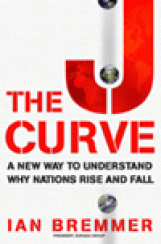
|
Over the next few years, China’s leaders will make political decisions that help shape 21st century international politics and growth trends in the global economy. As a result, China’s domestic stability deserves our attention. The country certainly appears stable. We hear and read reports about a protest in this city and a demonstration in that one. But China’s economy continues to fire on all cylinders. That’s the bigger story, isn’t it?
Policymakers, analysts, and all who hope to forecast the direction of China’s development need a new framework with which to understand how its leaders will help shape China’s (and our) future. The J curve offers such a framework. The J curve maps the complex relationship between a state’s stability and the degree to which it is “open”—both within its borders and to the outside world.
In short, there are two kinds of stability: that which is threatened by change and that which is reinvigorated by it. Some states (North Korea, Iran, Cuba, and a few others) are stable precisely because a small governing elite has isolated the country from the outside world. Much effort is expended by these countries’ governments to resist pressure for change.
Other states (France, the United States, and Japan, for example) are stable because they are “open” to social, political, and economic change. These states are able to absorb shocks because their political systems respond to the needs of their citizens and because investors in their stability have faith that conflicts will be peacefully resolved by independent governing institutions.
The J curve is the visual representation of this idea. Imagine a graph on which the vertical axis measures a state’s stability and the horizontal axis measures its “openness.” (See illustration) Each state appears as a data point on the graph. Taken together, these data points produce a pattern very much like the letter J. Nations higher on the graph are more stable; those lower are less stable. Nations to the right of the dip in the J are more open. Those to the left are less open.
The dip in the J represents the transition from one sort of stability to the other—from a stability based on imposed isolation to a stability based on adaptability and dynamism. When a left-side state (stable because it is closed) begins the transition toward becoming a right-side state (stable because it is open), it must first pass through a period of potentially dangerous instability. Some states, like South Africa, survive the journey. Other states, like the Soviet Union, do not.
Openness is a measure of the extent to which a state allows people, ideas, information, goods, and services to flow freely across its borders in both directions. How much foreign direct investment is there in the country? How much local money is invested in other countries? How many books written in another language are translated into the local language? How much direct contact do locals have with foreigners? How free are citizens to travel outside the country? What percentage of a nation’s citizens has access to foreign media? By these measures, China is far more open than it used to be, though a recent crackdown on both domestic and foreign reporting on sensitive political issues signals the state’s determination to monopolize the distribution of certain types of information.
But openness also refers to the movement of people, resources, information, and ideas within the country. Are citizens able to communicate freely with one another? Do they have access to accurate information about events in other parts of the country? Are they free to travel within the country without restriction? Are freedoms of speech and assembly legally enforced? How transparent are the processes of local and national government? Do citizens have access to and influence with their leaders? Here, China is not open by any measure.
China’s police-state politics consign it to the left side of the J curve. But its leaders are hoping to beat the system—by engineering a transition from left to right without a slide down the curve into instability. In essence, they’re gambling that by generating ever-increasing levels of prosperity for China’s people, they can bring the country fully into the international community without unleashing the instability that flows from the opening up of an authoritarian state.
But the J curve illustrates China’s dilemma: the economic opening that makes the country so attractive for foreign investors and lifts China’s standard of living now threatens its political stability by generating demand for a different kind of openness—greater governmental accountability.
The Chinese leadership continues to crush any effort to create political pluralism. Chinese journalists have been arrested. Foreign newspapers have been restricted. Large numbers of Internet cafes have been closed. Any organization that might become a focal point of opposition to the state is closely monitored. But the state’s ability to eliminate dissent is limited. According to the Chinese government itself, the number of large-scale protests across the country appears to have risen at virtually the same rate as GDP growth over the past several years.
Maybe that’s because China’s economic opening has created expectations for greater freedoms—as well as new opportunities to discuss them. The government hopes to keep a lid on all this discussion. Some 50,000 Chinese police are now charged with monitoring domestic Internet traffic. But 100,000 Chinese jump online for the very first time every day. Who’s going to win that race?
Can the Chinese Communist Party’s monopoly on political power survive the country’s economic opening to the outside world? Can China’s current system survive the eventual passage through the dip in the J curve? Perhaps double-digit growth and the middle class freedoms it has created will indefinitely keep a lid on public anger with the country’s authoritarian political system.
But maybe it won’t. The dangers of a sudden economic downturn (driven by a spike in global energy prices or the severe restrictions on travel into, out of, and around the country following confirmation of human-to-human transmission of bird flu, for example) could be unprecedented for China. The last time Chinese citizens experienced a sharp and sustained economic slowdown, they did not yet have the communications tools that might allow them to focus their anger at their government and to coordinate resistance should the state fail to meet their demands for change.
If the Chinese economy were to hit a wall, we might discover that the country is already closer to dangerous instability than we realize. The J curve suggests that this might well be the case.
Ian Bremmer, author of "The J Curve: A New Way to Understand How Nations Rise and Fall" and President of Eurasia Group.






